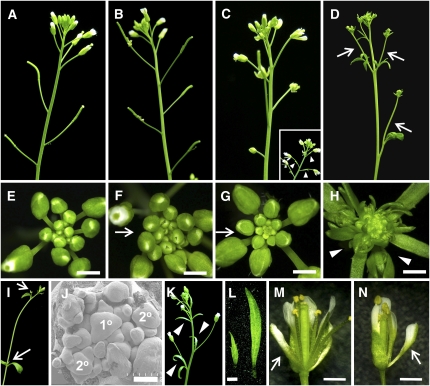Figure 5.
Genetic Interaction between puchi and bop Mutants.
(A) to (D) Forty-day-old primary inflorescences.
(A) The wild type.
(B) puchi-1.
(C) bop1-4 bop2-11. The inset shows an older (55 to 60 d old) inflorescence, producing visible bracts on the flower pedicels (arrowheads).
(D) puchi-1 bop1-4 bop2-11. Flowers are transformed into secondary inflorescence-like structures (arrows).
(E) to (H) Close-up view of inflorescence apices photographed when the inflorescences were ∼10 mm in length.
(E) The wild type.
(F) puchi-1.
(G) bop1-4 bop2-1.
(H) puchi-1 bop1-4 bop2-11.Unlike puchi and bop1 bop2 flowers (arrows in [F] and [G]), the triple mutant produces secondary inflorescences (arrowheads in [H]).
(I) A secondary inflorescence of puchi-1 bop1-4 bop2-11 in a position normally occupied by a flower in the wild type. Arrows indicate the formation of tertiary shoots in the leaf axils.
(J) Scanning electron micrograph showing a puchi-1 bop1-4 bop2-11 inflorescence apex at a similar stage to (H). Primordia produced by the primary inflorescence meristem (1°) behave like inflorescence meristems rather than like flower meristems (e.g., primordia indicated with 2°).
(K) Sixty-day-old inflorescence of a puchi-1 bop1-4 bop2-11 triple mutant showing formation of flowers subtended by well-developed bracts (arrowheads).
(L) Typical bracts of bop1-4 bop2-11 (left) and puchi-1 bop1-4 bop2-11 (right). Note that puchi mutant flowers have rudimentary bracts that are much smaller than those in double and triple mutants (cf. [L] with Figure 2B; see Supplemental Figure 2A online).
(M) Flowers of a bop1-4 bop2-11 double mutant.
(N) Flowers of a puchi-1 bop1-4 bop2-11 triple mutant.Arrows in (M) and (N) indicate sepal-petal hybrid organs in the first whorl.
Bars = 1 mm in (E) to (H) and (L) to (N) and 100 μm in (J).
[See online article for color version of this figure.]

